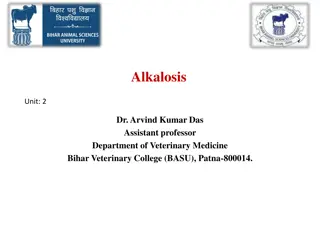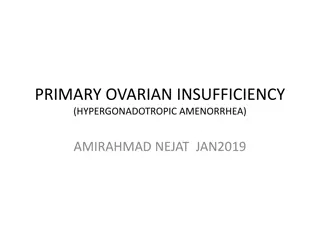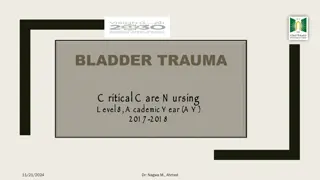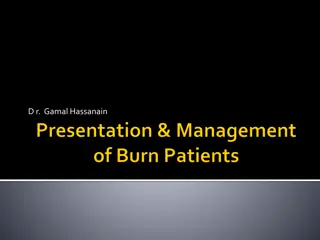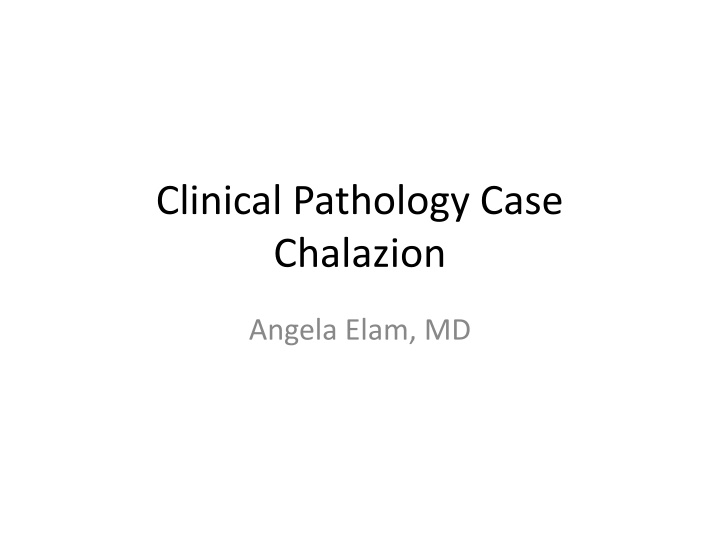
Chalazion: Clinical Features and Pathophysiology
Chalazion is a common eyelid condition caused by Meibomian gland duct obstruction. Learn about its clinical presentation, diagnosis, treatment options, and differential diagnoses. Images and pathophysiology explanations provided.
Download Presentation

Please find below an Image/Link to download the presentation.
The content on the website is provided AS IS for your information and personal use only. It may not be sold, licensed, or shared on other websites without obtaining consent from the author. If you encounter any issues during the download, it is possible that the publisher has removed the file from their server.
You are allowed to download the files provided on this website for personal or commercial use, subject to the condition that they are used lawfully. All files are the property of their respective owners.
The content on the website is provided AS IS for your information and personal use only. It may not be sold, licensed, or shared on other websites without obtaining consent from the author.
E N D
Presentation Transcript
Clinical Pathology Case Chalazion Angela Elam, MD
Clinical Course 61 yo woman with a raised, vascular-appearing upper lid lesion that had been present for a while Increasing in size over time Non-tender No (madarosis) lash loss Involving the lid margin
Clinical Course Ophthalmologist s clinical suspicion was for papilloma Wedge resection was performed and specimen sent to Pathology for evaluation (PHS12-35718)
Chalazion Granulomatous inflammation surrounding empty lipid vacuole Empty lipid vacuole PHS12-35718_4
Chalazion Multinucleated giant cells PHS12-35718_6
Chalazion Generalized lipogranulomatous inflammation Lipid vacuoles Giant cell Lipid vacuole PHS12-35718_2
Pathophysiology Meibomian glands are a sebaceous glands found in the eyelids They secrete the oily component of tears Chalazion formed when duct supplying a Meibomian gland is obstructed
Making the Diagnosis Clinical and pathologic diagnoses correlate more than 90% of the time When the diagnosis of chalazion is missed, sebaceous cell carcinoma is often the correct diagnosis, causing some to believe that all chalazion should be sent for pathologic evaluation Accuracy of the clinical diagnosis of chalazion. Ozdal et al. Eye 18; 135-138, 2004
Common Treatment Course Conservative = Warm compresses (many will resolve with conservative therapy) Medical = Topical antibiotics or subcutaneous steroids Surgical = Incision and removal
Differential Diagnoses Papilloma Molluscum contagiosum Eyelid Tumors (Examples: sebaceous adenocarcinoma, basal cell carcinoma) Preseptal cellulitis
Chalazion en.wikipedia.org Sebaceous cell carcinoma www.sarawakeyecare.com Basal cell carcinoma www.sarawakeyecare.com Papilloma www.oculist.net Preseptal cellulitus http://www.funscrape.com Molluscum contagiosum www.EyePlastics.com
Papilloma Most common benign eyelid lesion; Associated with HPV infection Keratinized epidermal fronds covering a fibrovascular core eyepathologist.com
Molluscum Contagiosum Lobular acanthosis, large basolophilic poxviral intracytoplasmic inclusions composed of poxvirus DNA www.missionforvisionusa.org
Sebaceous Adenocarcinoma Second most common eyelid malignancy; Can be misdiagnosed as a recurrent chalazion Lobules of anaplastic cells with foamy lipid-laden, vacuolated cytoplasm; large hyperchromic nuclei; skip areas www.mrcophth.com
Basal Cell Carcinoma Most common malignancy of the eyelid Blue basaloid tumor cells arranged in nests and cords www.mrcophth.com
References Basic Clinical Science Course: Cornea and External Disease. American Academy of Ophthalmology 2009-2010 Eye Pathology: An Atlas and Text, Second edition. Ralph Eagle, 2011 Review of Ophthalmology. Friedman, Kaiser, Trattler. 2005




